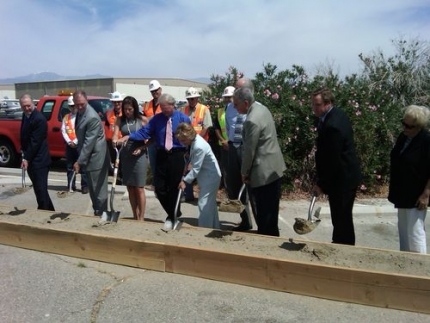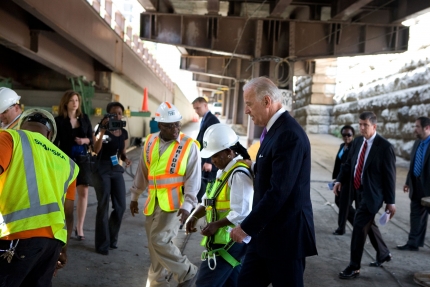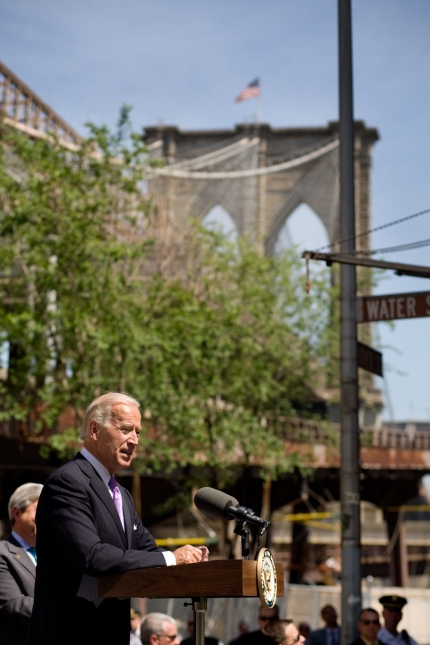The Recovery Act Blog
Clean Energy and the Summer of Recovery
Posted by on June 18, 2010 at 4:07 PM EDTToday I’m with Senator Jeanne Shaheen in New Hampshire to congratulate the state on meeting a major milestone under the Recovery Act. New Hampshire and eleven other states have now weatherized more than 30 percent of the homes they planned to complete under the Recovery Act. Increasing the energy efficiency of homes is especially important for New Hampshire, where more than half of homes use oil for heating.
Learn more about Energy and EnvironmentRecovery Summer: Solar Energy and Recovery Act-funded Building is Powering Our Economy and Our Pride
Posted by on June 17, 2010 at 7:37 PM EDTViewing this video requires Adobe Flash Player 8 or higher. Download the free player.The future of our economy will be built on green foundations. The evidence of this is clear in the projects funded by the Recovery Act, and the General Services Administration has committed itself to working towards a federal government with a zero environmental footprint.
Today, I walked the roof of the Philadelphia Veterans Affairs Regional Office and Information Center to view the solar panels that local contractors have recently installed as a result of funding under the American Recovery and Reinvestment Act. I met roofers, electricians, and solar panel manufacturers who were eager to tell me about the boost this project has brought to their businesses. The skills they’ve honed here will give such workers the competitive edge and innovative posture to attract and develop new products, services and markets.
I also learned about the placement of the panels with respect to the sun, the special finish to the roof allowing for proper reflection, and the weights placed around each panel to secure them without puncturing the roof. The ingenuity and pride of American business were on display, and we at the GSA were delighted to take a moment to applaud.
Learn more about EconomyA Summer of Recovery
Posted by on June 17, 2010 at 5:46 PM EDTWith tens of thousands of projects funded and millions of Americans on the job today, it’s hard to believe that it’s only been 16 months since President Obama signed the American Recovery and Reinvestment Act. And with so many jobs saved and created already, you might think that the Recovery Act’s greatest impact is behind us.
But it’s not.
As the summer heats up, it is becoming clear that it could quite possibly be the most active season yet when it comes to recovering our economy. There are Recovery Act-funded projects breaking ground across the country that are creating quality jobs for Americans and economic growth for businesses, large and small.
This summer is sure to be a Summer of Economic Recovery.
Learn more about EconomyFAA Uses Recovery Act Tools to Enhance Safety, Improve Facilities at U.S. Airports
Posted by on June 14, 2010 at 11:40 AM EDTCross posted from the Department of Transportation blog.
"Without the Recovery Act, we would not be here."
Those words were spoken by California Senator Barbara Boxer earlier this month as we broke ground for a new control tower at Palm Springs International Airport. The tower, which will improve safety considerably for the 71,000 takeoffs and landings each year, is one more good airport project made possible by funds from the American Recovery and Reinvestment Act.
The new tower will replace a 60-foot tower built in 1967 with a 150-foot tower. Solar panels will be installed atop the structure to provide power. With an unobstructed view of the entire airport, five controllers will be able to provide safe separation for aircraft and vehicle traffic on the tarmac and in airspace within a 5-mile radius and up to 3,000 feet.
Senator Boxer said that, thanks to the Obama Administration and Congress, "We did something very important here for our community, for safety, and for jobs."
Now, the proliferation of orange cones on our nation's highways this summer are visible signs of the Recovery Act working for America. But people might not be aware of the tremendous work the Federal Aviation Administration has done through the Recovery Act to improve our nation's airports.From March 23, 2009, the date FAA awarded its first ARRA grant, through last week, FAA has awarded 100% of its $1.1 billion in airport improvement funds. Construction is underway on all 362 airport improvement projects, and 239 of those projects are already substantially complete.
That means improved safety in airports across America. It also means over 3,000 jobs created or retained because of FAA-issued Recovery Act grants.
As California Representative George Miller noted recently, "Before this Congress and President Obama took decisive action, our nation was losing more than 750,000 jobs a month. It is clear that without the Recovery Act, our nation would be still dealing with an economic catastrophe."
The Recovery Act has enabled the FAA to improve runways, taxiways, aprons, terminals, aircraft rescue and firefighting buildings, airport equipment, noise mitigation, runway safety areas, and security.
These projects have not only meant jobs for thousands; they have also improved service and safety at US airports for everyone.Learn more about EconomyGet the Facts Straight
Posted by on June 11, 2010 at 11:50 AM EDTAn opinion piece by David Brooks in today’s New York Times reminded me of the old adage, “everyone has a right to their own opinion, but not to their own facts.”
Particularly in regard to the Recovery Act, Brooks gets the facts wrong and in so doing, presents a misleading picture of where we’ve been, where we are, and what the best next steps should be.
Jobs Saved or Created: Brooks cites a model that “suggests the stimulus will create about a half-million jobs.” That’s demonstrably wrong based on Recovery Act recipients’ own reports, and way off the consensus of outside estimates. Each of these facts is, btw, a mouse click away.
For example, click here and learn that according the Congressional Budget Office, the nation’s premiere, independent, nonpartisan scorekeeper, as of the first quarter of this year, the Recovery Act saved or created as many as 2.8 million jobs.
The CBO evaluates the jobs created by the full scope Recovery Act programs, from direct spending on road projects, to teacher-job preservation, to tax cuts, and so on. But there’s another source worth examining here: recipient reporting on Recovery.gov. Click on the link and you will see the number 681,825. These are the number of jobs reported by a subset of Recovery Act recipients, those whose jobs came through direct spending (missing, for example, jobs created by tax cuts or jobs created indirectly through spending by direct beneficiaries).
Note two things about this number: first, it reflects jobs created or retained with less than a fifth of the Act’s spending, and second, even though it only covers a small part of Recovery Act spending, it’s a lot higher than “half-a-million.”
Brooks may have objections to these facts, but it is misleading in the extreme to simply omit them.
Brooks then incorrectly cites the work of economist Ed Glaeser to suggest that there’s no relationship between stimulus spending and job creation. Glaeser finds nothing of the sort—the raw relationship Glaeser reports is that unemployment has risen less where the stimulus was larger (see here for a discussion of Ed’s work). I spoke to Ed this morning and he certainly believes the stimulus created jobs in states across the country.
Current Conditions: The other lynchpin of Brook’s argument is the fact that in the last jobs report, of the 431,000 net jobs created in May, only 41,000 were private sector jobs. In March and April, however, the number of private sector jobs created were 158,000 and 218,000, respectively. Every economist who follows these numbers knows they bounce around, so cherry-picking one month to make your case is just bad analysis (see here for a gaggle of economists making this important point). Presumably, Brooks wouldn’t have made this point last month, and it’s implausible that the stimulus worked in April but not in May.
The average of private sector job growth over the past three months has been about 140,000 per month. One year ago, that same average was negative 575,000…per month! Over the past three months, we’ve gained over 400,000 private sector jobs. Over that same period last year, we lost 1.7 million.
Economists across the spectrum widely agree that the Recovery Act played a key role in that reversal. Mark Zandi, one of the most frequently cited economists in America (and an economist who previously advised the McCain campaign), called the Recovery Act “the catalyst for the transition from recession to recovery.”
We know we have a long way to go before working Americans once again have the economic opportunities they need and deserve, and the President is working aggressively to build off of the momentum described above. But we can’t effectively plan next steps if we fail to objectively and factually evaluate where we’ve been.
Jared Bernstein is Chief Economic Advisor to the Vice President
Learn more about EconomyThe Brooklyn Bridge & the Story of American Workers
Posted by on June 3, 2010 at 12:33 PM EDTIf you’ve ever looked back at the old black and white photos of America being built, with hard-working men and women creating the infrastructure and fueling the economy that made our country what it is today, you may have stumbled across pictures like this where workers scaled dizzying heights to put the finishing touches on the Brooklyn Bridge back in 1881:
Over the past year and half, the Recovery Act has put hundreds of thousands of hard-working men and women to work on the same kind of projects for the 21st Century -- once again fueling America’s economy by repairing, rejuvenating, improving and advancing much of same infrastructure that was first created back then.
During a visit to New York City yesterday, Vice President Biden stopped by the Brooklyn Bridge where Recovery Act dollars are at work making a contribution to New York City's locally-funded effort to repair, upgrade, and preserve one of America’s most historic crossings.
After touring the construction site alongside Mayor Bloomberg, Vice President Biden spoke about how the $508 million project, which is funded in-part by the Recovery Act, will bring the Brooklyn Bridge into a state of good repair and improve traffic flow for the more than 120,000 vehicles, 4,000 pedestrians, and 2,600 bicyclists that cross every day.
“It’s great to see men and women back on the job, completing work on one of the truly, treasured landmarks this country possesses,” the Vice President told a crowd of about 40 construction workers near the Manhattan-side entrance to the bridge.
New York City says the Recovery Act’s $30 million investment in the project will create 150 jobs, generate economic activity and allow New York City to fund other critical infrastructure projects they otherwise would have eliminated or postponed. For the Brooklyn Bridge, it means a reconstructed roadway surface, rehabilitated and retrofitted steel support structures, expanded entrance ramps, and repainting to prevent corrosion.
As Vice President Biden noted, the Recovery Act has funded nearly 1,300 bridge projects and 14,000 transportation across the United States to-date.Liz Oxhorn is the Recovery Act Communications Director
Learn more about Economy
- &lsaquo previous
- …
- 2
- 3
- 4
- 5
- 6
- 7
- 8
- 9
- 10
- …
- next &rsaquo
White House Blogs
- The White House Blog
- Middle Class Task Force
- Council of Economic Advisers
- Council on Environmental Quality
- Council on Women and Girls
- Office of Intergovernmental Affairs
- Office of Management and Budget
- Office of Public Engagement
- Office of Science & Tech Policy
- Office of Urban Affairs
- Open Government
- Faith and Neighborhood Partnerships
- Social Innovation and Civic Participation
- US Trade Representative
- Office National Drug Control Policy
categories
- AIDS Policy
- Alaska
- Blueprint for an America Built to Last
- Budget
- Civil Rights
- Defense
- Disabilities
- Economy
- Education
- Energy and Environment
- Equal Pay
- Ethics
- Faith Based
- Fiscal Responsibility
- Foreign Policy
- Grab Bag
- Health Care
- Homeland Security
- Immigration
- Innovation Fellows
- Inside the White House
- Middle Class Security
- Open Government
- Poverty
- Rural
- Seniors and Social Security
- Service
- Social Innovation
- State of the Union
- Taxes
- Technology
- Urban Policy
- Veterans
- Violence Prevention
- White House Internships
- Women
- Working Families
- Additional Issues






